John Stokes and Mary's Gardens
Twelve Flower Meditations
Twelve Flower Meditations suggested by the Flowers of Our Lady
Flower Meditations
Christian flower symbolism, with origins in the Wisdom and Prophetic books of the Bible, was applied to Mary by the Church Fathers, as an extension of Isaiah's prophecy of the Virgin Mother of the Messiah as the Blossoming Rod of Jesse - celebrated today in the Christmas Carol, "Lo, How a Rose 'ere Blooming."
In time, the Flowers of Our Lady came to symbolize many envisaged aspects of Mary's life, virtues and mysteries, and as such served to quicken devout persons beholding them in nature and garden to Marian meditation and prayer.
This devotional tradition has been preserved in "Flowers of Mary," a series of 31 meditational flower addresses - one for each day of Mary's month of May - delivered in May, 1858 in Ingolstadt, Germany by Rev. Louis Gemminger, then Pastor of St. Peter's Church, Munich - published in English Translation in 1894.
The following are twelve meditations in the spirit of Father Gemminger.

Impatiens has been named Mother Love from the constancy of its blooms during the entire period from spring to frost - bringing to mind the constancy of Mary's love for her Divine Son and Lord, and for us, her spiritual children. We turn to Mary, our Mother, in prayer, knowing she is constantly present in heaven as our Advocate and Intercessor, yet also at our side mediating the graces she obtains for us. From the sense of Mary's presence and graces received in contemplating its sacramentally blessed Flowers of Our Lady, the mother Mary Garden at Woods Hole has been called "Our Lady in her Garden".

As the shapes of snapdragon blooms bring to mind little shoes, we envisage in our imagination the little feet and shoes of Jesus, and Mary's loving motherly sharing and bonding with him as she cared for him in their Nazareth home. In imitation of Mary, may we ever nurture and protect the innocence and purity of our own children as we instruct them in the truths and virtues of the Faith.
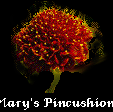
As we look at the tiny white pins in the flower heads of sweet scabious, we think of Our Lady's wonder and joy as she sewed garments for the Divine Redeemer she was to bear. In emulation of Mary, we offer all our work and thoughts to God, and, in particular, our sewing for home and for our church altar.
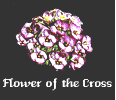
The tiny cross-shaped flowers of sweet alyssum bring to mind Christ's Cross, quickening us to recollection that all our pains and sorrows were borne there by him, and that by our own bearing of them in union with him we extend the mystery and efficacy of his Redemption - "making up what is wanting in the sufferings of Christ."

Consider the red poppy, one of the flowers said by old legend to have sprung up at the foot of the cross from Jesus' redemptive blood drops. These Passion symbols quicken meditation on Christ's Redemption of us, of the world of nature, and of the earthly Kingdom, so that the divine goodness, beauty, truth and glory of Creation may be shown forth, shared and magnified in the New Heaven and the New Earth for all eternity.

When the tear-like buds of larkspur appear, we unite our thoughts with those of Mary as she wept at the foot of the Cross, sharing interiorly the bitter Passion of her crucified Divine Son and Lord. May we become ever more closely united with the sacrifice of Christ through loving emulation of Mary's immolative motherly sorrows - as we are quickened to meditation and prayer by these flowers said by legend to have sprung up where her tears fell to the ground beside the Cross.

As we observe the first florets of cornflower blooming in a crown-like ring around the edges of each flower head, we raise our thoughts to Mary's coronation as Queen of Heaven and Earth. We pray to her for the mediation of the graces needed by us ever to guide our actions towards the redemptive building of God's Peaceable Kingdom of truth, justice, love, freedom and material sufficiency for all - in preparation for the transformation of all in the New Heaven and New Earth on the last day.
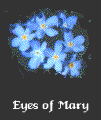
As we come upon the eye-like flowers of forget-me-nots, with their golden centers, we are quickened to reassurance that the eyes of Mary, our Spiritual Mother in heaven, are always turned upon us and our needs. We are similarly reassured by the downwards inclining blooms of the daffodil, seen as "Mary looking down from heaven".

We see how beautifully the golden masses of marigolds suggest Our Lady's splendor after her glorious assumption into heaven, and her "coming forth as the morning rising . . . bright as the sun" from the interior of the Trinity, as the "Woman clothed with the sun" and "Queen in gilded clothing"; and in her subsequent merciful appearances on earth. We ask her to pray that we may obtain the promise of heaven.
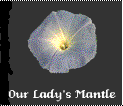
We raise our thoughts from the blue of the morning glory, "Our Lady's Mantle" to the spiritual mantle with which Mary, Mother of the all-powerful God, and our heavenly mother also, mercifully protects those who turn to her for help. We beseech her protection from all dangers.
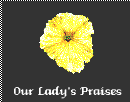
The blooms of petunias were named Our Lady's Praises from their perceived resemblance to the subtle flowers seen by those gifted with spiritual vision to rise from the lips of devotees proclaiming Our Lady's praises - as spiritual roses were perceived to rise from the lips of those praying theAves and Paters of the Rosary (the origin of the name, "Rosary"). Or, alternatively, they may be seen as praises rising from the lips of Mary, as her soul "magnifies the Lord." May our prayers, too, rise to Our Lady and to God as pure spiritual bouquets of love.
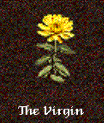
The zinnia is one of a number of flowers whose forms and settings in nature suggested to persons coming upon them the presence of the radiant heavenly human form of the Virgin, for whom the flowers were then named. Other such flowers are "Mary", "Our Lady of the Meadow", "Our Lady in the Corn", "Our Lady by the Gate". As we reflect on the yellow zinnia as it first blooms, with a single haloed glorious flower above its foliage "body," we rejoice that Mary, Mediatrix of all Graces, is always present with us by her action wherever graces are distributed.
Copyright Mary's Gardens 1998
Photos copyright 1992-1997 FLOWERscape garden design software, by Richard H. Kline - All rights reserved
The John Stokes and Mary's Garden collection was transferred to the Marian Library in May 2013. In addition to his archives, manuscripts, artwork, and personal library, John S. Stokes also donated his extensive website. It was transferred to the Marian Library in early 2010. This particular entry is archived content original to Stokes' Mary's Gardens website. It is possible that some text, hyperlinks, etc. are outdated.